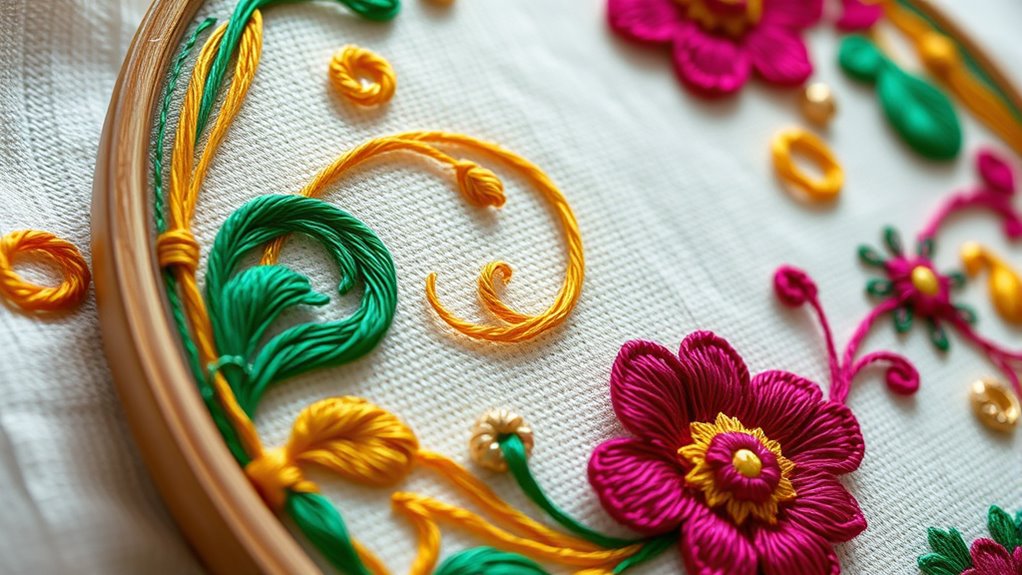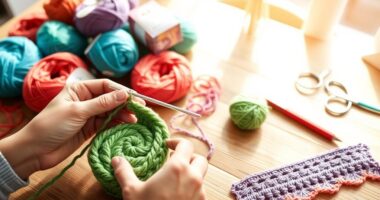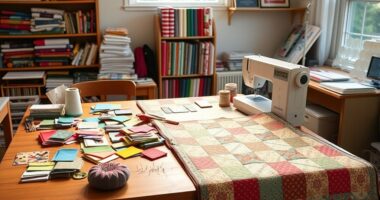The embroidery renaissance blends traditional stitches like satin, back, and chain with modern patterns inspired by contemporary art, digital themes, and pop culture. You can explore innovative designs that mix geometric shapes, abstract motifs, and classic techniques, making your projects both timeless and trendy. This movement encourages creativity and self-expression while maintaining a connection to embroidery’s rich history. Keep exploring further, and you’ll discover how to harness these techniques to create truly unique pieces.
Key Takeaways
- Traditional embroidery stitches like satin, back, and chain are being revitalized and integrated into modern, innovative designs.
- Contemporary motifs inspired by art, pop culture, and digital themes are combined with classic embroidery techniques.
- Embroidery now spans diverse applications, from wall art to fashion accessories, encouraging creative self-expression.
- A vibrant community and online resources make learning new techniques accessible for beginners and experts alike.
- The movement balances honoring traditional craftsmanship with exploring bold, innovative patterns for a dynamic art form.

You might be surprised to discover that embroidery is experiencing a vibrant revival, blending traditional techniques with modern designs. This renaissance is not just about preserving old crafts; it’s about reinventing them to suit contemporary tastes. At the core of this movement are traditional stitches—simple, time-honored methods like satin, back, and chain stitch—that you can easily learn and incorporate into your projects. These foundational techniques serve as the backbone for creating intricate textures and patterns, providing a tactile connection to embroidery’s rich history. Yet, what really sets this revival apart is how these classic stitches are now being used to craft innovative, eye-catching designs that resonate with today’s aesthetic preferences.
Embroidery’s revival blends traditional stitches with innovative, modern designs for a fresh creative expression.
As you explore this new wave of embroidery, you’ll notice how artists and hobbyists alike are integrating contemporary motifs into their work. These motifs often draw inspiration from modern art, pop culture, and even digital themes, making embroidery feel fresh and relevant. Imagine stitching geometric shapes, abstract forms, or stylized icons alongside traditional floral or paisley patterns. This blending of old and new allows you to experiment freely, creating pieces that are both timeless and trendy. You don’t have to be a master to start; even simple stitches can be combined with bold, contemporary motifs to produce stunning visual effects. The key is to balance the familiarity of traditional stitches with innovative design ideas, resulting in pieces that feel both rooted in history and entirely modern.
The beauty of this embroidery renaissance lies in its versatility. Whether you prefer hand-stitched wall art, embellished clothing, or personalized accessories, you can adapt traditional stitches to suit your style while exploring new motifs. It’s a process that encourages creativity and self-expression, giving you the confidence to break free from conventional patterns and develop your unique aesthetic. Additionally, this movement is accessible; with online tutorials, workshops, and a growing community of enthusiasts, you’re never far from inspiration or support. Engaging with these resources can help you learn new techniques and discover popular embroidery styles, expanding your creative horizons. As you experiment with combining traditional stitches and contemporary motifs, you’ll find endless ways to push the boundaries of embroidery, making each project a reflection of your individual voice.
In essence, this embroidery revival invites you to honor the craftsmanship of the past while embracing the limitless possibilities of today’s design landscape. By mastering traditional stitches and exploring contemporary motifs, you become part of a vibrant movement that celebrates innovation rooted in tradition. It’s a perfect time to pick up your needle, experiment with new ideas, and contribute to this exciting renaissance that’s transforming embroidery into a dynamic art form for the modern world.
Frequently Asked Questions
What Are the Origins of Modern Embroidery Patterns?
You’ll find that modern embroidery patterns originate from a mix of historical motifs and cultural influences. Artists draw inspiration from traditional symbols, adapting them with contemporary styles and techniques. This fusion creates fresh, innovative designs that honor past craftsmanship while reflecting current trends. By blending old motifs with new inspirations, you can develop unique patterns that showcase both history and culture in your embroidery work.
Which Materials Are Best for Contemporary Embroidery Projects?
For contemporary embroidery projects, you should choose fabrics like cotton, linen, or even silk, depending on your design and texture preferences. Use sharp, fine needle types such as embroidery or crewel needles to achieve precise stitches. These materials and needles work well together, ensuring your embroidery looks professional. Opt for fabric choices that match your project’s purpose, and select needle types that glide smoothly through your fabric for a seamless crafting experience.
How Can Beginners Learn New Embroidery Techniques Quickly?
Think of embroidery as a garden that blooms with practice. To learn new techniques quickly, start with basic stitches using quality embroidery tools. Follow skill-building exercises daily, like tracing patterns or practicing specific stitches. Watch tutorials or join workshops to see techniques in action. Consistent practice and patience turn small steps into mastery, helping you grow your embroidery skills faster and more confidently.
What Are Upcoming Trends in Embroidery Design?
You’ll see upcoming embroidery trends focusing on digital motifs and eco-friendly threads. Incorporate digital motifs to add modern, intricate designs easily, and choose eco-friendly threads to appeal to sustainability-conscious audiences. Expect more personalized, vibrant patterns blending traditional techniques with digital inspiration. Experimenting with these trends keeps your work fresh and relevant, allowing you to stand out while supporting eco-conscious practices in your embroidery projects.
How Can Embroidery Be Incorporated Into Fashion and Home Decor?
Imagine blending delicate embroidery on accessories with bold wall art to transform your space. You can incorporate embroidery into fashion by embellishing handbags, jackets, or shoes, adding a personalized touch. For home decor, create striking embroidery wall art or pillowcases that showcase intricate patterns. This fusion of textile art and everyday items elevates your style and environment, turning simple pieces into stunning, handcrafted statements.
Conclusion
As you explore the embroidery renaissance, it’s clear that modern patterns and techniques breathe new life into this ancient craft. Some believe this revival is driven by a desire to reconnect with tradition, while others see it as a response to the digital age’s need for tangible, handcrafted art. Regardless of the reason, embracing these innovations allows you to participate in a timeless movement, proving that even age-old art forms can evolve and thrive in today’s world.








